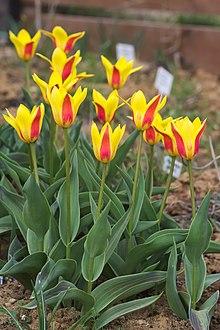|
Tulipa kaufmanniana
Tulipa kaufmanniana, the water lily tulip, is a species of tulip native to Central Asia.[2] DescriptionThe tulip has a short stem, 20–25 cm (8–10 in) long,[3] making it a dwarf tulip.[4] It has lance shaped leaves which may be plain green,[3] or blue-green.[5] They also often have purple markings on their leaves.[6] It is one of the earliest tulips to bloom,[3][4] between February and April.[5] The funnel-shaped flower,[3] has six pointy petals that open out like a star similar to water lilies, hence the common name.[5] They open very wide on sunny days.[4] They usually have outermost petals with a different colour than interior petals.[6] The long upright petals often have a flushed orange-red,[5] red or purple flush on the back of the petal.[3] Inside the petal, there may be a butter-yellow,[5] or yellow blotch and sometimes with further red markings.[3] There are also red, orange, pink and clear yellow forms too.[5] After it has flowered it will form seeds.[7] TaxonomyIt is commonly known as the 'Water-lily Tulip'.[8] because the petals of the flower open out like a star or waterlily.[5][3][4] The Latin specific epithet kaufmanniana refers to Konstantin von Kaufman (1818–1882) who was the first Governor-General of Russian Turkestan where the tulip was found. It was first found in Turkestan,[9][10] and then published and described by Eduard August von Regel in his botanical magazine 'Gartenflora' Vol.26 on page 194 in 1877.[11][9][12] It was also published by Regel in Act. Hort. Petrop. Vol.5. on page 265 in 1877.[9] Distribution and habitatTulipa kaufmanniana is native to temperate areas of Central Asia.[12] It has naturalised between southern Europe, North Africa, and Asia from Anatolia and Iran in the west to northeast of China.[7] Range It is found in Kyrgyzstan,[12] Tajikistan and in Kazakhstan.[5] As well as found on the mountains of Tien-Shan,[5][13] the Pamir and Hindu Kush mountains.[7] HabitatT. kaufmanniana grows in the wild on stony hillsides,[5] and steppes.[7] CultivationThey are suitable to be grown in the rock garden, bed and borders.[4] It is suitable for growing in USDA Growing Zones: 3 to 8, in full sun and soils with medium moisture retention or well-drained soils.[10] Seed germination of the tulip has been studied, and it was concluded that stratification for 7 weeks was more effective treatment on studied traits than 5 weeks. Moreover, cold stratification was a better treatment on breaking seed dormancy of the seeds.[7] Cultivars They and their hybrids are placed in Group 12, the Kaufmanniana Group, by the Royal Horticultural Society.[6] Their leaves often have dashes and streaks of purple, which show the influence of Tulipa greigii in the breeding programmes.[3] It was given the First Class Certification by the Royal Horticultural Society in 1897.[14] The cultivars 'Ancilla', 'Early Harvest', 'Showwinner' (deep red[5]) and 'Stresa' have gained the Royal Horticultural Society's Award of Garden Merit.[15][16][17][18] Two other Group 12 cultivars are listed by the RHS as gaining the Award of Garden Merit, 'Alfred Cortot' and 'Glück'.[19][20] Other known hybrids include 'Heart's Delight', a soft pink with an orange-yellow eye, the clear yellow 'Chopin' and white 'Concerto'.[5] In America, common cultivars include; 'Ancilla' soft pink, red and white flowers, 'Johann Strauss' rosy red and sulfur yellow blooms and 'Stresa' golden yellow with carmine red flowers.[4] CultureIn the 1960s, a postage stamp in CCCP (Russia), was issued with an image of the tulip.[21] Then in 1993, a postage stamp in Uzbekistan, within the Flowers series was issued with an image of the tulip.[22] References
Other sources
|
||||||||||||||||||||||||||||||||||||
